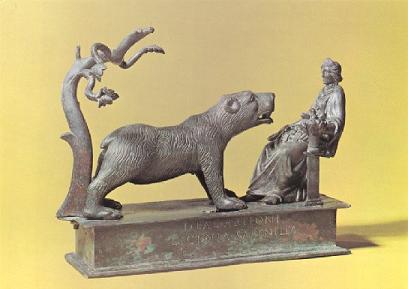
Artio Bear Goddess Photo used with permission
From Robin @ www.inanna.virtualave.net
Artio: Celtic Bear Goddess
By Wave Walker (Donna)

Artio Bear Goddess Photo used with permission
From Robin @ www.inanna.virtualave.net
In the Gallo-Roman religion, Artio is the ‘Bear Goddess’ and was worshipped at Berne, which actually means ‘bear’.
Artio is seen above in a statue found now in the Historisches Museum in Bern, Switzerland.
This statue was uncovered in a vegetable garden in Muri, Switzerland in 1832.
The inscription reads “Deae Artioni Licinia Sabinilla “– “To the Goddess Artio from Licinia Sabinilla”. (one of our sisters of yesteryear).
Other inscriptions to this Goddess have been found at Daun and Stockstadt in Germany; also in Weilerback in Luxembourg.
The Celts ancestors came from what is today Germany, Austria and
Switzerland bringing their Gods and Goddess with them.
The Helvetii , a celtic tribe who migrated from the area of modern
Bavaria to Switzerland worshipped Artio as the ‘She- Bear’. This tribe
eventually became a part of the Roman Empire and the Gaul and Roman
Gods and Goddess took on each other’s attributes. Some believe that
Artio then was absorbed into the Goddess of Diana as the tribes were
taken over by the Romans.
Both the Roman Goddess Diana and the Greek Goddess Artemis are
attributed to bears in myths and may have gained this from the
followers of Artio.
Throughout all of Celtic Gaul and Britian there have been similar deities that appear in bear form as the Goddess of wildlife.
Making this an important part of their spiritual life.
The Celtic tribes sometimes shortened her name to Art, in Irish Art
meant God ; but its earlier meaning was ‘Bear Goddess.’ Stone figures
of bears have been found in many digs of ancient Celtic past; some were
found during the restoration of Ireland’s Armagh Cathedral in 1840.
Based on the niches found in caves across Europe which hold bones and
skulls of bears have been found to be arranged with care; many
archaeologist have claimed that the bear is the oldest European deity.
About 6,000 years ago the ancestors of the Celts invented the ‘Old
Europe Script’ it is known to be the earliest proto-language. The first
ever written sentence reads: “The Bear Goddess and the Bird Goddess are
the Bear Goddess indeed.” Dr. Toby Griffin who has been working on the
translation of this script believes that this means the Bear Goddess
and Bird Goddess have merged into a single deity. This deity later
became Celtic Goddess Artio, Roman Goddess Diana and the Greek Goddess
Artemis.
Some believe she was absorbed into Christianity as The British
Saint Ursula (‘Little Female Bear’) a Latinized form of the Saxon
‘Ursel’ meaning (‘She Bear’). Her feast day is October 21 which would
follow along with the harvest attribute of Artio.
Both the Roman Goddess Diana and the Greek Goddess Artemis are
attributed to bears in myths and may have gained this from the
followers of Artio.
|
|
Poem to Artio |
|
Artio's sacred things:
Artio is believed to have been absorbed into the Roman Goddess Diana when her people became a part of the Roman empire.
So many of Diana’s sacred attributes could also be from Artio.
Ritual to thank Artio
Altar:
Directions:
“Praise Artio for your love of the beasts
Such compassion and peace
Humbled I am by your selfless love
Guide me as I open my eyes, spirit, and mind
To the life of our sisters and brothers of the land”
Sources:
www.celtnet.org.uk
www.inanna.vitualave.net
www.wikipedia.org
Also from these books:
Animals in Celtic life and myth by Miranda Green
Roman Trier and the Treveri by Edith Mary Wightman
This
page
is the intellectual and creative property of WaveWalker
June 2009